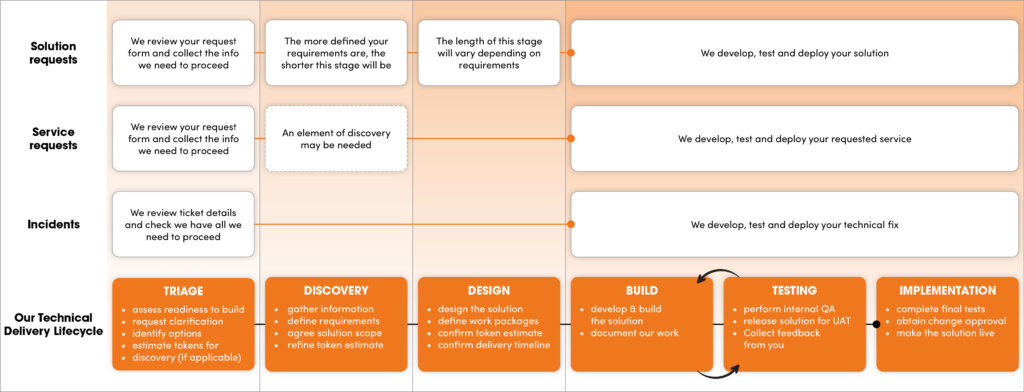Achieving better outcomes with our new Lifecycle approach
At CIH Solutions we always believe in ensuring our valued customers receive the best possible service from us, delivered in the most transparent ways we can.
That’s why we’ve been working hard behind the scenes to define our new ‘Technical Delivery Lifecycle’ (or just ‘Lifecycle’ for short), a structured approach to how we will work with you.
We’re excited that we’re now ready to implement this process with our existing managed service customers at the start of 2024 – as well as offering it to all our new customers.
Here’s a short summary of what it will mean for you in practice and why we’re doing it.
What is our Technical Delivery Lifecycle approach and what’s different about it?
In reality, it’s not actually a new approach for us – it’s more of a clarification of how we’ll have been working with you already. It’s also likely to be familiar to you in other ways, as it’s similar to most standard project processes.
In a nutshell, it follows six key stages, which are as follows

Why are we introducing our Lifecycle approach?
In the past, we may not have always followed the process consistently, and each stage may not always have been entirely transparent to our customers. So, clearly defining the approach in this way and presenting it to you now ensures that everyone will always be on the same page, whatever we’re working on. You’ll know what to expect at each current and future stage of the process – and, most important of all, it will help to achieve the best possible outcomes when working with us.
How will it work in practice?
In all cases, our focus will be to agree with you, at the earliest moment possible, two key milestones: the implementation (i.e. ‘go live’) date and, before that, the start date for testing (or UAT – user acceptance testing – as we often call it).
For all development work, we’ll follow the Lifecycle in full.
However, for other types of work, we may not need to include every stage – or we may be able to skip through some of the stages rapidly.
For example, when you report an incident, as soon as we have all the information we need, we’ll focus on putting a solution in place for you. Similarly, when you raise a service request, we’ll already have a good idea of what you need, so we’ll be able to spend less time in discovery and design.
However, in other cases, we may need to spend more time on certain stages. For example, when you come to us with a business opportunity or problem, we’ll need to put a strong focus on the discovery and design elements to help you to find the best solution.
When will we formally introduce the Lifecycle?
We’ll be adopting this approach early in 2024. In parallel, we’ll be moving to a new ITSM tool that better supports this optimal way of working.
How can you find out more?
Over the next few weeks, we’ll release a series of articles that take a deeper dive into each stage, so you can understand what this approach will mean in practice for you and your organisation.
And rest assured, before we launch this new approach, we’ll meet with every customer separately to walk you through the changes and give you the chance to ask any questions.
Our top priority is to ensure you fully understand this way of operating and the benefits it will bring to your organisation.
We look forward to meeting with you in due course – but if you have any questions now, please don’t hesitate to get in touch.



